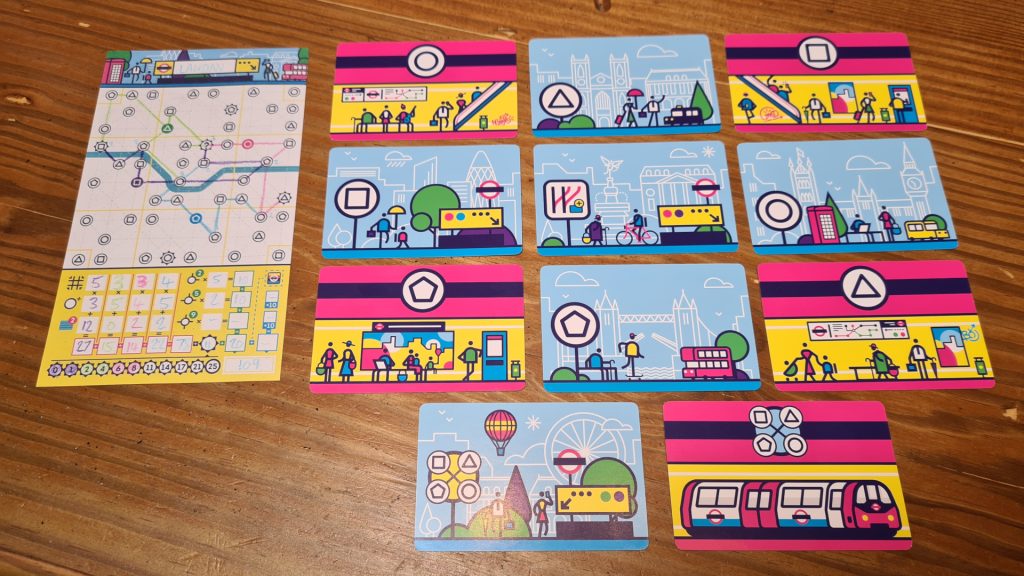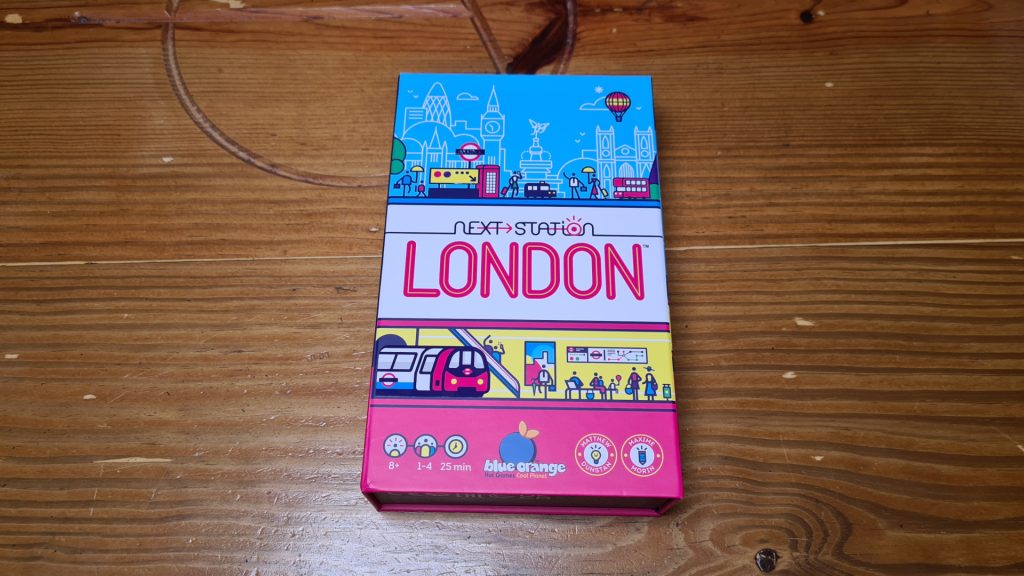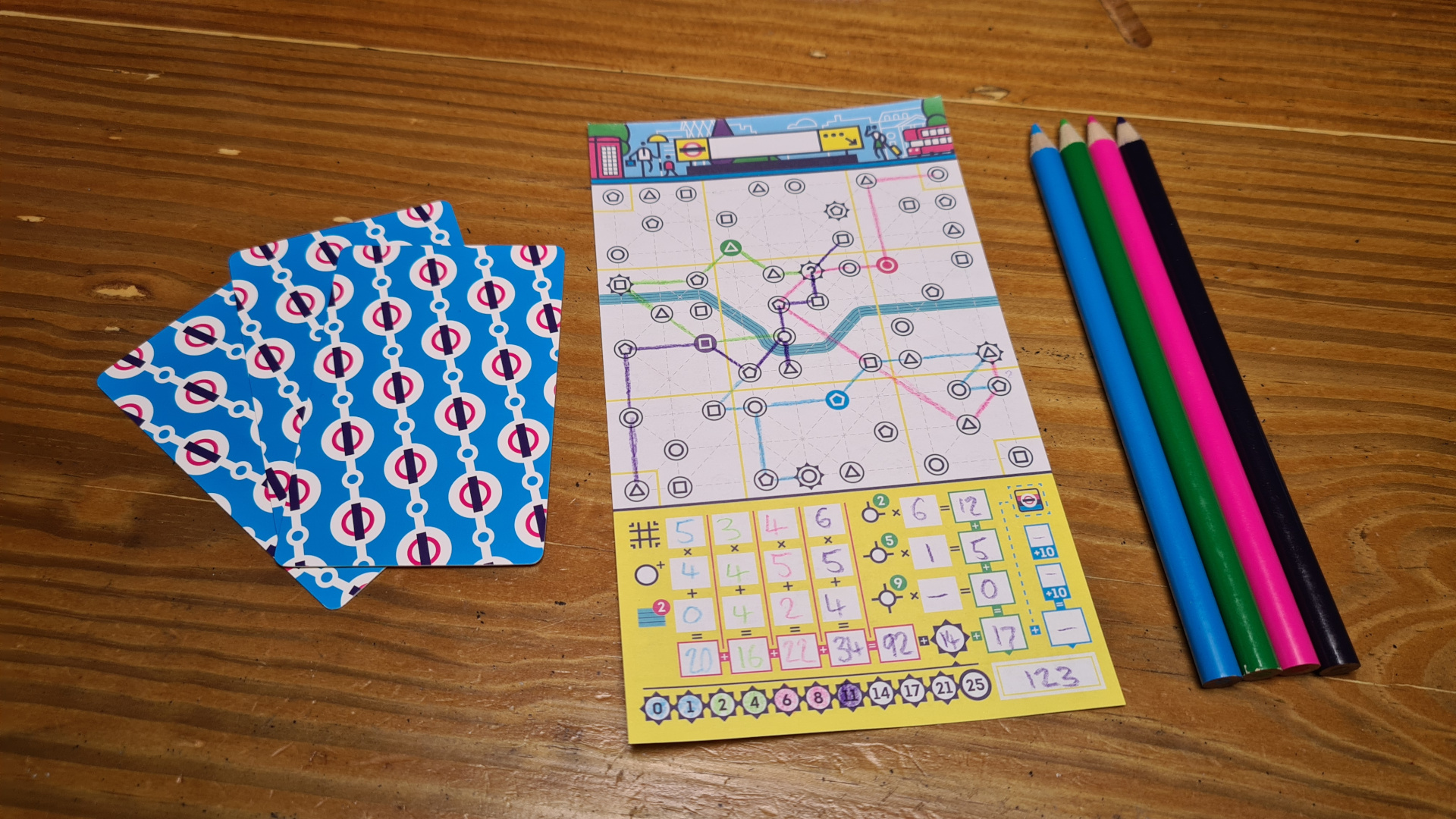Next Station London is the brand new 2022 release from Blue Orange Games. Designed by Matthew Dunstan, featuring artwork from Maxime Morin, the game sees 1 – 4 players delving into train line drawing in this flip and write experience. Tackling an abstracted layout of London, players will be drawing lines to link up tourist sites, wiggle back and forth under the river Thames and create interchange hubs for passengers. However, is this a network players will want to keep revisiting? Let’s find out!
At the start of the game each player takes a map sheet and randomly one of the coloured pencils. The colour of pencil each player has indicates the line they will be drawing for the round. If less than 4 players are playing, spare pencils are placed between players for future rounds. After shuffling the deck of station cards the game is ready to begin.
Players will be drawing lines from stations on their map sheet, growing one line each round. Each turn the top card is flipped from the deck. All players simultaneously use the result of the revealed card. The cards normally show one of the four shapes (Triangle, Square, Circle or Pentagon). Whichever symbol is revealed the players can extend their current line from either end to a Station of matching symbol. There are some limits as players can only draw along the dotted straight lines. Lines cannot cross each other, nor reuse a dotted route for a second line, so as players draw they add their own restrictions for later routes. Routes also cannot skip over stations, though players can choose not to use revealed symbols. The river Thames looks like it may be another restriction to work around, instead players want to cross it for bonus points.
A few special symbols appear in the deck and on the map sheets. Two wild cards are in the deck allowing players to connect to any station symbol. As standard players cannot split their lines, only extend from either end. One card in the deck allows a split to be made through – which isn’t guaranteed to be flipped. 5 of the cards in the station deck are pink Underground cards. Play continues with cards being flipped and used until all 5 of these are revealed. Thus, the round lengths are slightly dynamic, though the same for all players. Dotted across the board are stations denoted as tourist sites. These stations work in the same way but will gain the player bonus points at the end of the game for each time they are visited, with a tracker at the bottom of the sheet with values to cross off.

At the end of a round players score their just drawn train line, before passing their pencil on to the next player. The map of London is split into 13 districts, 9 main regions and 4 secondary districts in the four corners. Players count the number of districts the line passes through and they multiply it by the number of stations visited in one district along the route (whichever district has most). For each time the route crossed the Thames they gain a bonus of 2 points.
Each round is scored the same way, with additional scoring performed after the final round. In addition to the 4 scored lines players check how far they got on the tourist site track, earning the next uncrossed value as points. Finally, players score for their interchange stations, those where 2 or more lines connect to the same station. With 2 points for stations with 2 lines up to 9 points per station with all 4 lines it can be well worthwhile designing your underground system with many connections. Combining all of this, whoever has the most points wins, with ties split by the single highest scoring underground line.
Almost a third of the rulebook is dedicated towards two advanced modules which can be included to add that bit extra into the Next Station London experience. The first 5 card module is shared objectives. Two of these are randomly revealed before play starts offering hard but rewarding challenges. Ranging from a line going through all 13 districts to linking 5 tourist sites these are worth 10 points to all players which manage them – though will often cause some disruption for later lines.
The second module Pencil Powers sees each player randomly get one of the four player players. Passed on with the pencil at the end of the round; these range from treating one station card as wild to counting a station as a double station for scoring, and each player will get a chance to use each across the course of the game. They might be small decks, and additional objectives or powers would have been nice. Still, these do add to the experience to help players want to come back for repeat plays.
Next Station London presents gamers a real conundrum. Every route drawn will be potentially scoring points but it’s also slowly but surely closing off parts of the map for later turns and rounds. Not using a symbol seems initially a negative, trying to use every single one to get the most stations linked. At what expense are you doing this through? Perhaps drawing long cutting lines will make future underground lines falter or just be painful to avoid. The point scoring doubles down on this, making players want to get many different underground lines to go into the same stations as hubs. This can score big but also makes areas more congested and hard to build out from or around later on.

Players get points for a number of different objectives, and the game needs them all to feel thematic but also so the puzzle and engagement are retained after a few plays. It makes sense that players will want lines to connect various districts but not just jump from one to the next. It’s intuitive that key locations (the tourist sites) need to have train services hence they earn points and that places to switch underground lines would be good for the imaginary passengers. With points coming from so many angles it’s hard to have a bad turn. Not quite every single time you draw a line will it score you points though it is close to being so.
With such quick turns and rounds once the game is over it’s a bit of a letdown that pointing up takes a bit of time. While the majority isn’t more than some multiplication it’s hard to track the interchange stations. In a video game where all this would be determined by the game and points spat out at the end it would be fine. It’s a shame that at the end of the game there’s a chunk of time calculating points to see who has won. The speed at which the rest of the game is played just makes this slow process stick out more.
Coming in a small box, with a premium feeling magnetic close, Next Station London is a rather portable game. The game also takes up a very small footprint on a table, with players needing enough room for their map sheet and a small deck of cards. There isn’t that much in the box component wise, a few piles of cards, 4 coloured pencils and the pad of 100 map sheets. Each does its job well, though a couple of the colours used for the pencils could have been darker to better pop from the white background.
Next Station London is a thoroughly interesting puzzle sort of networking building game. Everyone is using the same flipped cards but by the end of the game no one has similar looking underground lines. With every card flipped there is a choice and often those can come back to bite you, or at least be something to work around for later lines. The calculation of points from interchange stations at the end of the game is a tad slow, but with subsequent plays this does improve and for the variety of ways to score is an important inclusion. Overall, it’s a fun puzzle whether soloing to beat your previous scores or against others, and could be a great game for families as long as you don’t mind helping out with a bit of maths.

